Spotty survival
The northern spotted owl faces unpredictable threats and an uncertain future.
Biologist Lowell Diller knows how to make friends with a northern spotted owl.
He gently strokes the feathers on the bird’s forehead, right above its eyes. The owl, which had been flapping around as Diller held its feet, immediately calms down. It gazes up at Diller, almost in a trance, as the biologist measures its size and weight, makes sure it’s healthy, and slips an identification tag around its foot.
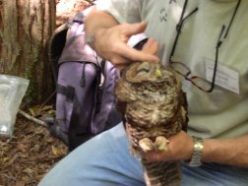 |
|
Biologist Lowell Diller soothes a captured northern spotted owl by stroking the feathers on the bird’s forehead.
|
| Kate Ramsayer |
He wants to make the owl feel as relaxed as possible. That way, if he needs to catch it again, the bird might remember the head massage and the free mice Diller feeds it and not immediately fly away.
Diller keeps track of spotted owls as part of his job. He’s a senior biologist at Green Diamond Resource Company, a timber company based in Seattle. Ever since 1990, when the United States government declared northern spotted owls a threatened species, timber companies must make sure they don’t harm or disturb the birds.
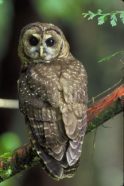 |
|
Northern spotted owl.
|
| John and Karen Hollingsworth, U.S. Fish and Wildlife Service |
On government lands, big chunks of owl-friendly habitat are set aside, off-limits to loggers.
But northern spotted owls are still in trouble. The number of owls is declining in many areas, and they face threats that won’t easily disappear. For example, the barred owl appears to be bullying spotted owls out of their territories. And some scientists are concerned that spotted owls might start dying from West Nile virus.
“Right now there’s more uncertainty than there has been, in my opinion, and it’s because of these two unknown threats,” Diller says. “We can’t predict how they’re going to turn out.”
Declining numbers
Northern spotted owls live in the western parts of northern California, Oregon, Washington, and British Columbia. They roost in stands of trees that are hundreds of years old.
In these old-growth forests, large trees mix with smaller trees, with dead trees called snags, and with trees having broken tops or holes in which the owls can make their nests. Some studies suggest that the owls can also live in forests made up of younger trees, as long as there’s still a variety of sizes and types of trees.
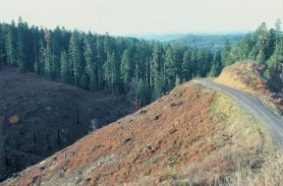 |
|
In Oregon, a logging method known as clear-cutting has completely removed trees from a portion of a forest where northern spotted owls could live.
|
| Steve Hillebrand, U.S. Fish and Wildlife Service |
But, as settlers moved into the Pacific Northwest, many cut down vast numbers of trees for timber. One study estimates that, since the early 1800s, people destroyed between 60 percent and 88 percent of potential spotted owl habitat.
The loss was so great that, when forest managers started protecting owl habitat 14 years ago, they suspected that the number of spotted owls wouldn’t immediately bounce back. Now, the number of owls in northern California and parts of Oregon is holding steady, but the owl population in Washington and British Columbia is getting smaller.
“Some of the populations are still continuing to decline,” says Rocky Gutierrez. He studies spotted owls as a professor at the University of Minnesota. “But others have shown a stabilizing trend,” he says. “We think that’s due to the protection of habitat.”
Bullying birds?
Scientists have a possible suspect for the decline.
“In the past 60 years or so, the barred owl has invaded the range of the northern spotted owl,” Gutierrez says. “The stage is set for competition to occur.”
And, so far, it looks like the barred owl is winning. Previously, barred owls lived in the eastern United States. Slowly but surely, they migrated across Canada and down the West Coast, into spotted owl territory.
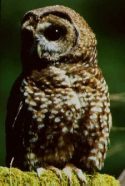 |
|
Barred owl.
|
| U.S. Fish and Wildlife Service |
Barred owls are closely related to northern spotted owls, but they are slightly bigger. They live in the same habitats as spotted owls do and eat similar food, although they seem less finicky.
Barred owls are also more aggressive. Some scientists say that the barred owls are kicking spotted owls out of the few areas where spotted owls can live.
“The biggest wild card right now is the barred owl,” says Robin Bown. She’s a biologist with the U.S. Fish and Wildlife Service. “If you create the habitat, you don’t know if you’re going to get barred owls or spotted owls.”
Still, scientists can’t be sure that the barred owls are causing the decline in spotted owls. Right now, they only have observations, Bown says. They can see that there are fewer spotted owls in areas where there are more barred owls, but they don’t have any direct proof that barred owls are the culprit.
Gutierrez is interested in doing experiments to test the idea scientifically. He is planning to play recordings of barred owl calls and spotted owl calls near sites where spotted owls nest. He’ll play different combinations of the recordings to see if the spotted owls respond after the barred owl calls or if they keep quiet, not wanting to attract attention.
“At this point there’s a great deal of scientific uncertainty about how these two species interact,” he says.
But if barred owls turn out to be the bullies of old-growth forests, people can’t simply make rules to make them share the forest, as they did to slow down logging.
“The biggest problem is that there’s not much you can do,” Bown says. Instead, biologists can only hope that the two species of owls learn to live together. Or, perhaps spotted owls will settle into a habitat that their barred owl cousins don’t like. It’s an issue that scientists will keep a close eye on.
Other threats
Spotted owl biologists are also paying attention to other threats. Recently, West Nile virus has infected several birds of prey. While there haven’t been any known cases of West Nile among spotted owls, Diller says it could happen this spring.
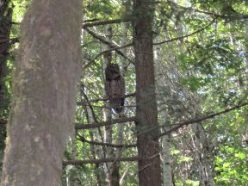 |
|
An adult spotted owl watches visitors from its perch high in a tree.
|
| Kate Ramsayer |
Certain species of birds are resistant to West Nile and don’t get sick. But some birds die when infected. The biologists will just have to wait and see what happens with spotted owls.
Weather can also play a role in spotted owl survival. Rain ruffles the owls’ feathers so that they can’t fly as quietly to sneak up on their prey. If the spring is wet and owls can’t catch as many flying squirrels or dusky-footed woodrats, they might not have any chicks.
Although there are many factors that people can’t control, there are some factors they can control.
“Habitat is still an issue, and, if anything, it may be a bigger issue now because we’re losing spotted owl sites to barred owls,” Bown says.
So, forest managers are continuing to set aside patches of federal land for owls. On timber company lands, biologists such as Diller are drawing up habitat conservation plans to make up for areas the companies log.
Still, it looks like spotted owls will need help from all the friends they can get.
Going Deeper:







